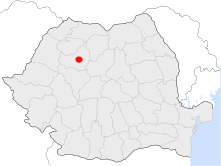Cluj-Napoca
|
|
Cluj-Napoca (Hungarian: Kolozsvár; German: Klausenburg; Latin: Claudiopolis), the seat of Cluj county, is one of the most important academic, cultural and industrial centers in Romania. Regarded as the historic capital of Transylvania, the city is located in northwestern Romania, and is approximately 480 km (200 miles) northwest of Bucharest in the Someşul Mic valley.
| Contents |
History
Cluj-Napoca has a very rich historical and cultural heritage. The city stands on the site of an ancient Dacian settlement, Napoca, which the Romans first made a municipium and later a colonia. From the 3rd century it was the seat of the procurator of Provincia Porolissensis. Colonized by Saxons in 1178, the city at this time received its German name of Klausenburg, from the old word Klause, meaning mountain pass. In 1270 it was given urban privileges by King Stephen V of Hungary and began to grow quickly: the Saint Michael Cathedral was built under King Sigismund. By this time the number of Saxon and Hungarian inhabitants were equal, and King Matthias Corvinus (who was born here in 1440) ordered that the chief judge should be Hungarian and Saxon in turn. However, between 1545 and 1570 large numbers of the Transylvanian Saxons left the town due to the introduction of Unitarian doctrines, and the city became a center for Hungarian nobility and intellectuals.
The first Hungarian newspaper appeared in Kolozsvár in 1791, and the first Hungarian theatrical company was established in 1792. In 1798 the town was destroyed by fire to a great extent.
From 1830 to 1848, as capital of Transylvania and the seat of the Transylvanian diets, the city became the centre of the Hungarian national movement in the principality. During the Revolutions of 1848, Kolozsvár was taken and garrisoned in December by Hungarians under the command of the Polish general Józef Bem.
After the First World War Kolozsvár, renamed Cluj, along with the rest of Transylvania becomes part of the Kingdom of Romania. In 1940 Cluj was returned to Hungary by the Vienna Award, but Hungarian forces in the city were defeated by the Soviet and Romanian army in October [[1944]. Cluj was restored to Romania by the Treaty of Paris in 1947.
Recent romanization and the reign of ultra-nationalist mayor Gheorghe Funar has hit the multi-national character of Transylvania's capital hard, with the Hungarian population now reaching barely 20%.
In 1994 and in 2000, Cluj-Napoca hosted the Central European Olympiad in Informatics (CEOI). It thus made Romania not only the first country to have hosted the CEOI, but also the first country to have hosted it a second time.
Population
From the Middle Ages on, Cluj-Napoca has been a multicultural city with a diverse cultural and religious life. As of 2002 the city's population was 317,943 (ranked third in Romania after the capital Bucharest and Iasi). The ethnic composition, according to official sources is: 252,433 Romanians (79.4%), 60,287 Hungarians (19%), 1% Roma, 0.23% Germans and 0.06% Jews.
Economy
Ursus beer is brewed here. The city is served by the Cluj-Napoca International Airport.
Education
CJROuniexterior.JPG
CJROuniinterior.JPG
Cluj-Napoca is one of the most important Romanian academic centres.
- Universities:
- Babeş-Bolyai University (the largest in the country with more than 43,000 students) offering 105 specialisations in Romanian, 52 in Hungarian, 13 in German and 4 in English official site (http://www.ubbcluj.ro)
- Technical University of Cluj-Napoca (with more than 12,000 students) official site (http://www.utcluj.ro)
- Iuliu Hatieganu University of Medicine and Farmacy (with more than 6,000 students) official site (http://www.umfcluj.ro)
- Universitatea de Ştiinţe Agricole şi Medicină Veterinară official site (http://www.usamvcluj.ro)
- Art and Design University
- Gheorghe Dima Music Academy official site (http://www.amgd.ro)
- Some private universities: Dimitrie Cantemir Christian University (more than 1,500 students), Avram Iancu University, Bogdan Vodă University
- Some important colleges: Liceul de Informatică Tiberiu Popoviciu, Liceul Teoretic Lucian Blaga, Liceul Emil Racoviţă, Liceul Gheorghe Şincai, Liceul Nicolae Bălcescu, Liceul George Coşbuc, Liceul Mihai Eminescu, Liceul Onisifor Ghibu
Some tourist attractions
The tourist not-to-miss list should definitely include the following:
- the Avram Iancu Square with the Orthodox Cathedral, the National Theatre and the Avram Iancu Statue
- the Unirii Square with the Catholic Cathedral and the Matei Corvin Statue
- the Universităţii Street with the Babeş-Bolyai University
- the Mihai Viteazul Square with the Mihai Viteazul Statue
- the Lucian Blaga Square with the University Library
- the Botanical Garden
- the George Baritiu Street with the Technical University
- the Cetăţuia with its wonderful panorama of the city
- the Central Park
- several museums: Transilvanian Ethnographic Museum (including its open air section), History Museum, Art Museum, Zoology Museum, Farmacy Museum
See also
- Cluj-Napoca Botanical Garden
- Cluj county
- Modern architecture in Cluj-Napoca
- Cathedral of Saint Michael
- Banffy Palace
External links
- Virtual trip of Cluj-Napoca (http://www.therealtransylvania.com/journeys.html)
- Cluj Napoca Map (http://www.cluj4all.com)
- Official website of Cluj-Napoca (http://www.clujnapoca.ro) (in Romanian)
- Official website of Kolozsvár (http://www.kolozsvar.ro/) (in Hungarian)
- Official website of the City Hall (http://www.primariaclujnapoca.ro)
- Events in Cluj-Napoca (http://www.cluj.info) (in Romanian)
- Cluj-Napoca online community (http://groups.msn.com/ClujNapoca) (in Romanian and English)bg:Клуж-Напока
de:Cluj-Napoca eo:Cluj-Napoca es:Cluj-Napoca fr:Cluj-Napoca hu:Kolozsvár ja:クルージュ・ナポカ la:Claudiopolis pt:Cluj-Napoca ro:Cluj-Napoca sv:Cluj-Napoca



